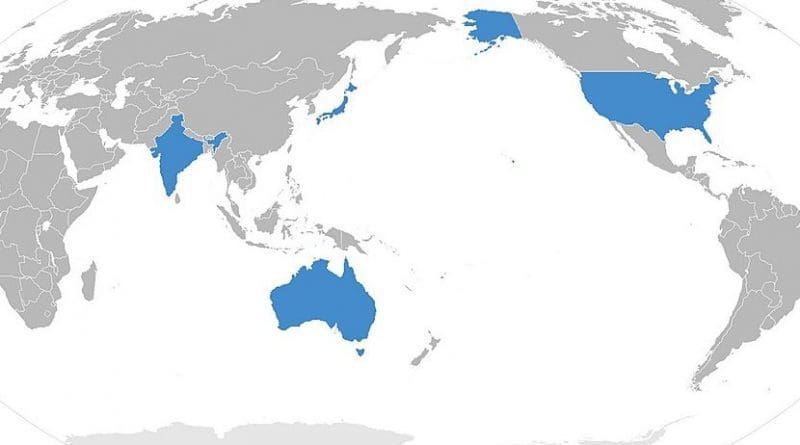Quad To Quad-Plus: A Cost-Benefit Assessment – Analysis
By IPCS
By Siddharth Anil Nair
A decade since its inception, the India-Japan-US-Australia Quadrilateral (or ‘Quad’), finds itself still beset by a lack of consensus and formalisation. It has also been criticised for being unable to effectively engage ASEAN members to reach some consensus on the Indo-Pacific Region (IPR).
This commentary will assess the pros and cons of the Quad’s possible shift into a more inclusive format – the Quad-plus. Could the Quad-plus facilitate minilateral relations between core Quad (CQ) members and ASEAN countries in a way that also furthers each country’s national priorities in the areas of economics, security, and infrastructure development?
Why Quad-plus?
ASEAN finds itself in the background of a US-China rivalry in the IPR, which has led to its own formulation of an IPR vision. Freedom of navigation, economic cooperation, peaceful dispute settlement, and respect for sovereignty are values enshrined in its ASEAN Outlook on the Indo-Pacific 2019. As the IPR witnesses increasing economic dependence on China, decreasing US political engagement, and an absence of middle-powers – India and Japan – as effective alternatives, ASEAN has begun to push for self-led mechanisms to govern the regional politico-military landscape.
The Quad-plus format would be an expansion of minilateral cooperation via track II interactions along three lines: maritime domain awareness (MDA), critical infrastructure, and economic interconnectivity. This would allow the Quad and ASEAN to align their regional priorities, making them better able to collectively defend the principles they espouse.
The Quad-plus can keep incentives high and disputes low by harmonising Quad and ASEAN views on the IPR (i.e. values, interests, spatial conceptions, etc.) and collectively developing security networks (naval, air, and counter-terrorism) and physical infrastructure. However, these positives will only play out in the long-term.
Quad-plus offers several benefits to the CQ. India has the opportunity to expand its domain awareness beyond the Malacca Strait and work on securing its economic ties to Southeast Asia. Japan can contend with immediate geopolitical anxieties in the East and South China Seas via security and economic cooperation with neighbouring ASEAN countries. The US can continue to maintain a counterpoint to China in the region through security and financial collaboration; and Australia can diversify trade with Southeast Asia and actualise its naval security ambitions.
ASEAN members, too, stand to benefit from a reconfiguration of the Quad. Countries could be better prepared to stave off Chinese territorial expansionism with the weight of the Quad behind it. The same template could be replicated with regard to their economic dependency on China. With such a counter-balance, ASEAN has the potential to set – and achieve – its own regional ambitions. It is critical, however, that the each country take on, within the broader framework of cooperation, their own area of expertise. For example, India and the US could look at security, Japan and the US could focus on financial investments, and so on.
Challenges
CQ members have recently reiterated their desire to maintain ASEAN’s centrality through dedicated investments in MDA, trade, and transcontinental infrastructure, following the India-Australia-Japan-US consultations in 2019. Translating this intent into action will require a strengthening of ties in existing fields, as well as non-traditional areas such as cyber/information security, energy and climate change, disaster management, etc.
However, the growing divergences between US political and military opinion on their regional priorities could stymie Quad aspirations. This, along with poor Indian and Japanese financial and logistical bandwidth to competitively invest in the IPR compounds the Quad’s shortcomings. Any significant commitment by India to the IPR also poses the risk of overextending critical military assets and de-prioritising existing undertakings in the Indian Ocean Region (IOR).
Ultimately, however, the primary hurdle are the complex economic relationships between the CQ and China – for all CQ members, China is either the first or the second largest trading partner, or a key import/export partner. Greater engagement with ASEAN through Quad-plus could give China more reason to counter-act in a way that negatively impacts both ASEAN and the CQ.
If the Quad begins a Quad-plus initiative, it will not only be confronting these challenges, but will also have to contend with other issues such as disputes even within ASEAN, and differing dispositions towards China.
Conclusion
China’s activities in the IPR have contributed to a convergence of regional priorities between ASEAN and the Quad. Actualising this convergence on multiple fronts could contribute to the disruption of China’s economic prominence in the IPR, and strengthen ASEAN-Quad security networks. To truly fortify these political and military synergies in the Quad-plus format, economic and infrastructural development must take centre stage.

